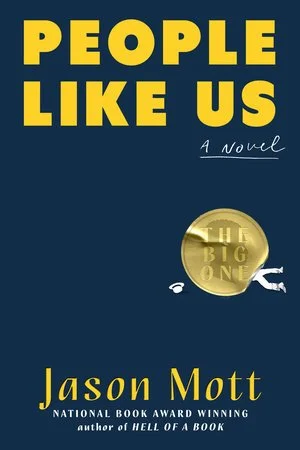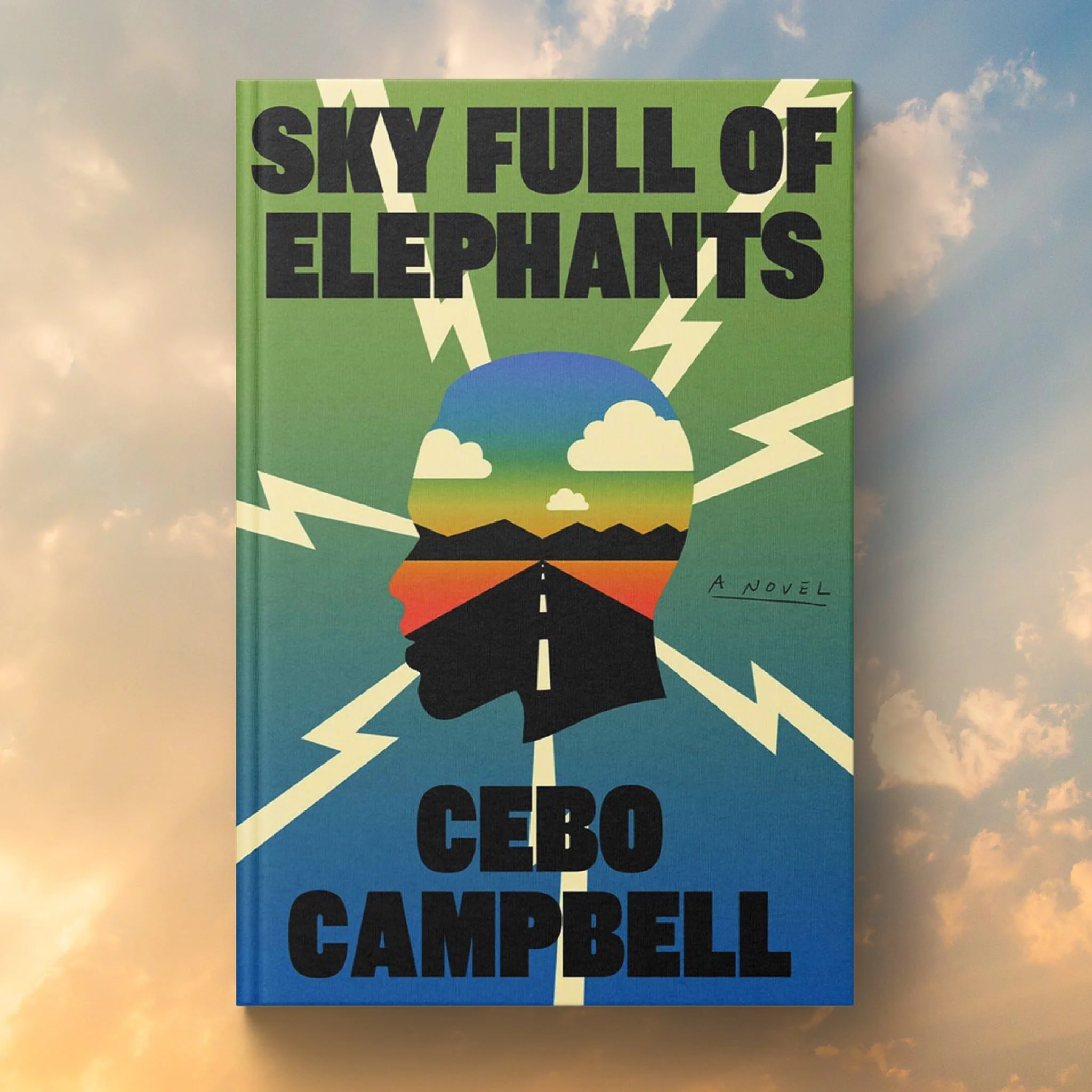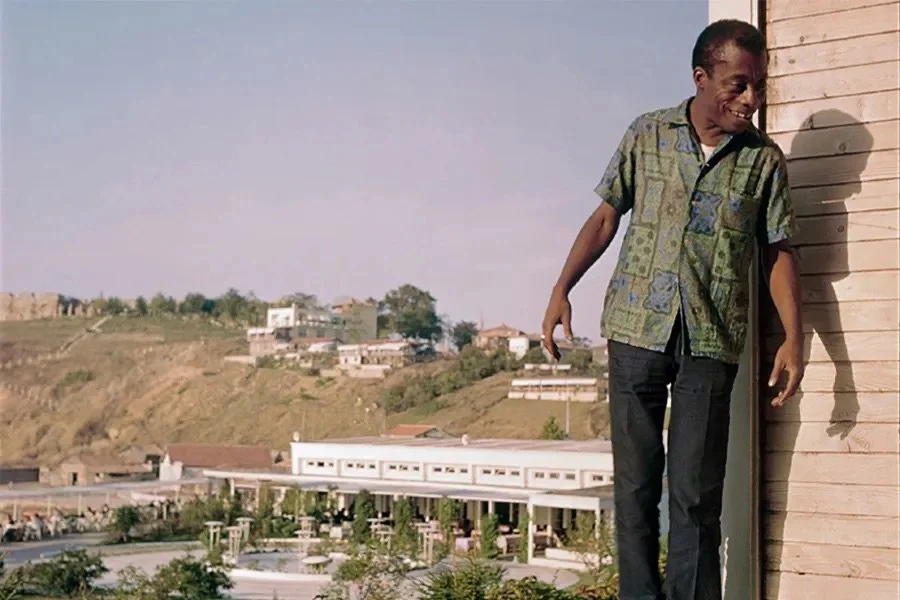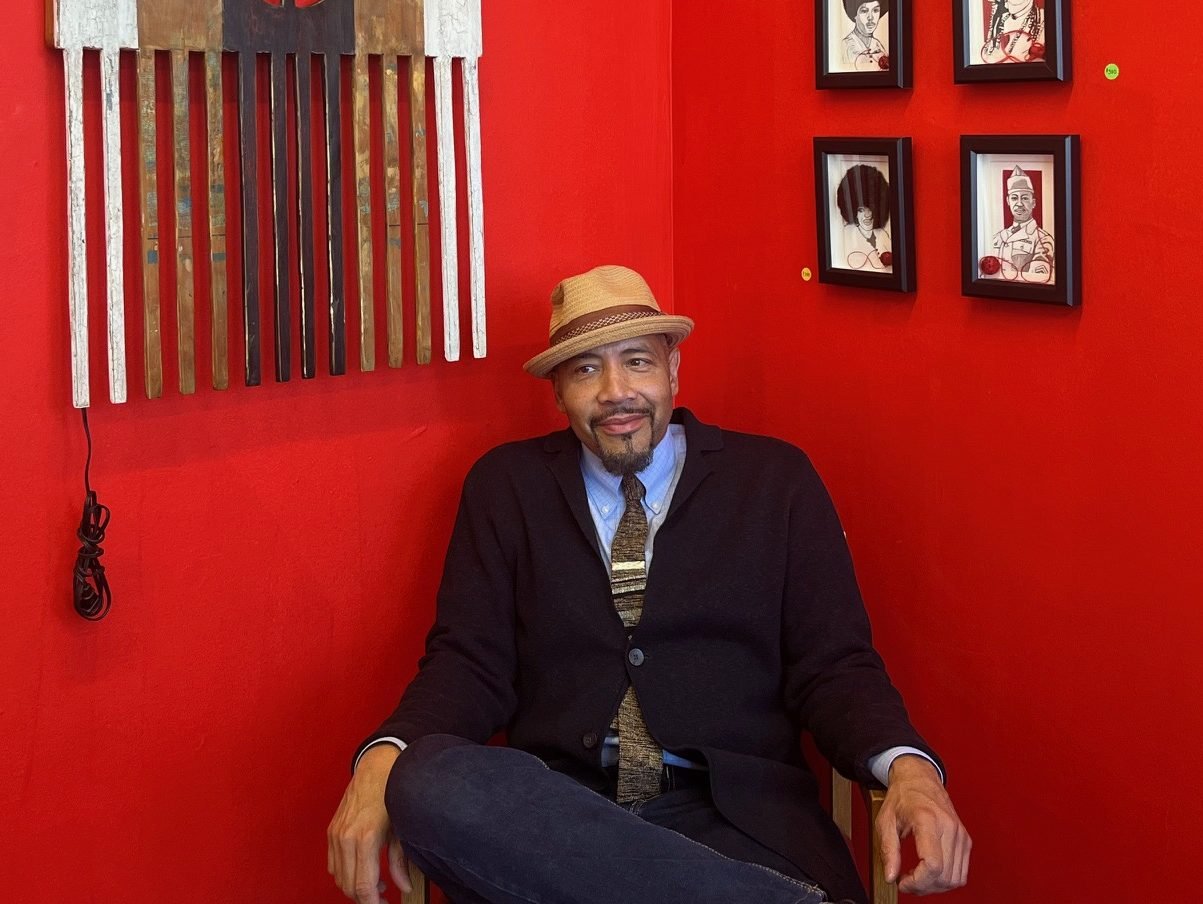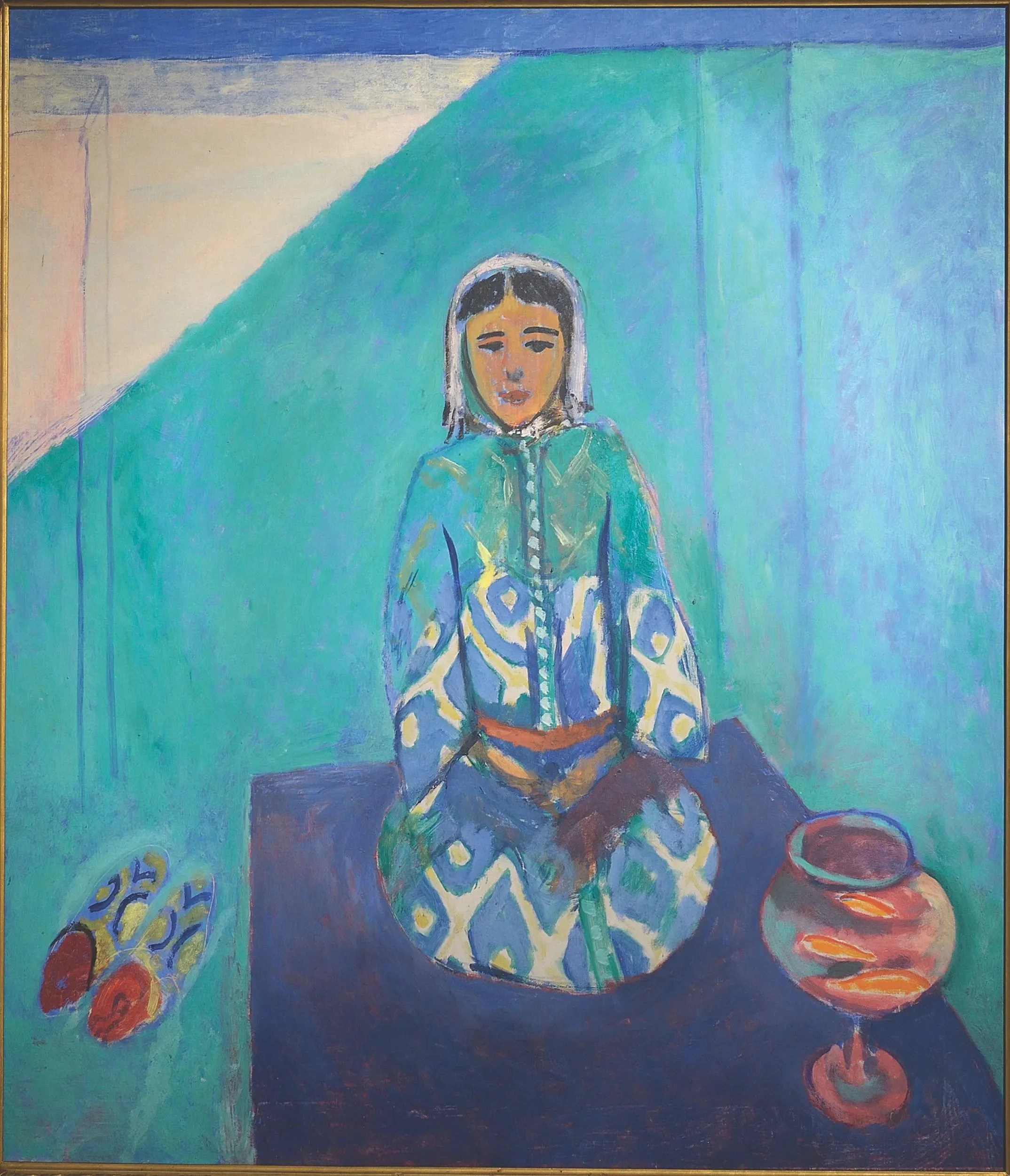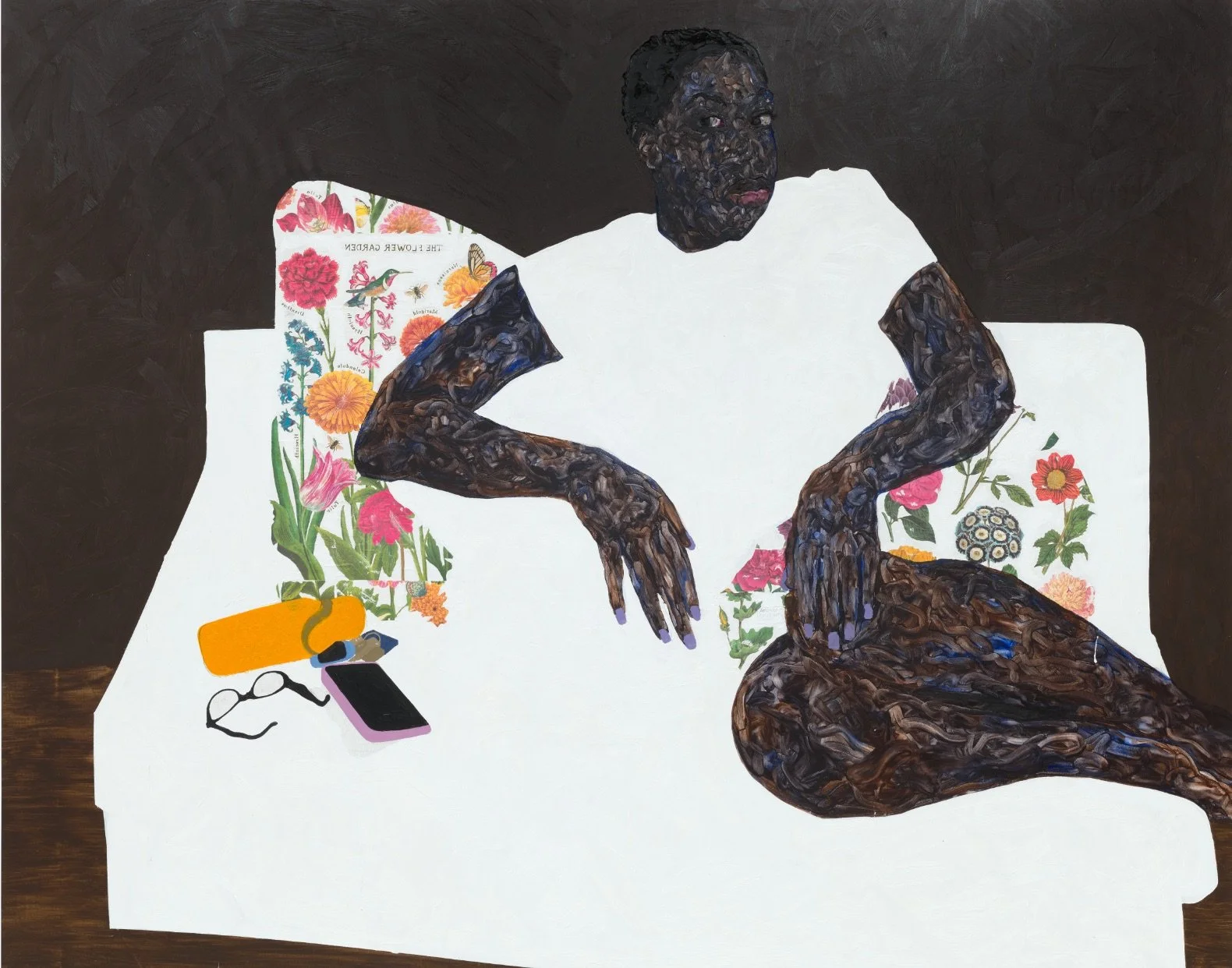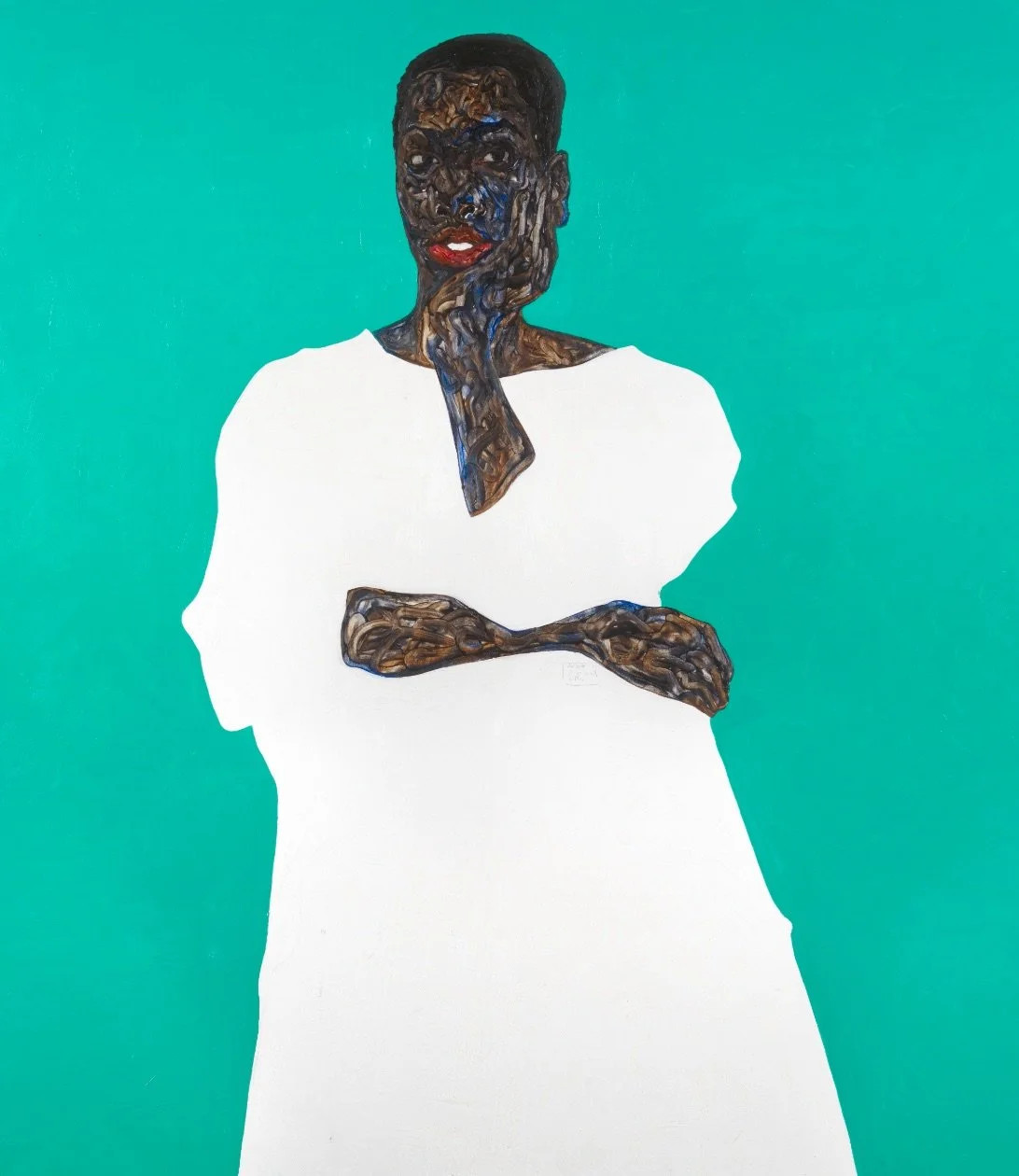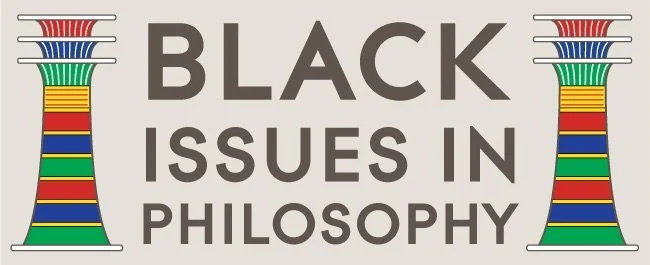TBN Recommended Books and Exhibitions Autumn 2025
Black Portraiture[s]: TULSA STORIES
October 3rd, 2025
9:30am - 5:00pm CDT
NYU Tulsa in Tulsa, Oklahoma
700 North Greenwood Ave, Tulsa, OK 74106
Room: Conference Center, Ground Level
In 2013, Black Portraiture[s] became an international conference series when it convened in Paris at the Musée du quai Branly-Jacques Chirac, co-hosted by Dr. Awam Amkpa, Dean of Arts and Humanities NYU Abu Dhabi and Dr. Cheryl Finley, Inaugural Director of the Atlanta University Center Collective for the Study of Art History and Curatorial Studies. Black Portraiture[s] now attracts hundreds of scholars, artists, and activists from around the world; convenings have since taken place in New York, Florence, Toronto, and Johannesburg among other cities.
The next iteration of Black Portraiture[s] will be held at NYU Tulsa in Tulsa, Oklahoma on October 3, 2025. Black Portraiture[s]: TULSA STORIES seeks to continue the robust scholarship and art conversations of our Black Portraiture[s] conferences by convening an intergenerational group of participating scholars, artists, activists, storytellers, educators, gallerists, and photographers to explore cultural memories and resistance. All day programming will include panels with themes such as: “Reimagining Tulsa,” “Black Wall Street,” “The Archive,” and “Art, Writing & Music,” and feature short presentations from a variety of speakers sharing their respective works/practice, moderated conversation, audience Q&A and final wrap-up. Subscribe to the Black Portraiture[s] mailing list to receive more information and updates regarding speakers and conference schedules.
An academic conference committed to the study of African diasporic art and culture, Black Portraiture[s] initially began as a colloquium on African American art at Harvard University convened by Dr. Henry Louis Gates Jr., Alphonse Fletcher University Professor and Director of the Hutchins Center for African & African American Research; with Dr. Deborah Willis, Chair and Professor at NYU Tisch Department of Photography and Imaging, Founding Director of the Center for Black Visual Culture; and Dr. Manthia Diawara, Professor at NYU Martin Scorsese Department of Cinema Studies and Director of the Institute of African American Affairs from 1992-2018.
Baldwin: A Love Story
Written by Nicholas Boggs
September 30, 2025, 7pm
In Conversation with Rachel L. Swarms
Parkway Central Library
1901 Vine St, Philadelphia, PA 19103
Baldwin: A Love Story, the first major biography of James Baldwin in three decades, reveals how profoundly the writer’s personal relationships shaped his life and work. Drawing on newly uncovered archival material and original research and interviews, this spellbinding book tells the overlapping stories of Baldwin’s most sustaining intimate and artistic relationships: with his mentor, the Black American painter Beauford Delaney; with his lover and muse, the Swiss painter Lucien Happersberger; and with his collaborators, the famed Turkish actor Engin Cezzar and the iconoclastic French artist Yoran Cazac, whose long-overlooked significance as Baldwin’s last great love is explored in these pages for the first time.
Nicholas Boggs shows how Baldwin drew on all the complex forces within these relationships—geographical, cultural, political, artistic, and erotic— and alchemized them into novels, essays, and plays that speak truth to power and had an indelible impact on the civil rights movement and on Black and queer literary history. Richly immersive, Baldwin: A Love Story follows the writer’s creative journey between Harlem, Paris, Switzerland, the southern United States, Istanbul, Africa, the South of France, and beyond. In so doing, it magnifies our understanding of the public and private lives of one of the major literary figures of the twentieth century, whose contributions only continue to grow in influence.
The Brothers’ Network September 2025 Book Selection: ‘Black Artists in Their Own Words’ Edited by Esteemed Art Historian, Lisa Farrington
What is Black art? No one has thought harder about that question than Black artists, yet their perspectives have been largely ignored. Instead, their stories have been told by intellectuals like W. E. B. Du Bois and Alain Locke, who defined "a school" of Black art in the early twentieth century. For the first time, Black Artists in Their Own Words offers an insightful corrective.
Esteemed art historian Lisa Farrington gathers writing spanning a century across the United States, the Caribbean, and the African continent—including from renowned artists Henry Tanner, Nancy Elizabeth Prophet, Romare Bearden, Wifredo Lam, Renee Cox, and many more—that reveals both evolutions and equivocations. Many artists, especially during the civil rights era, have embraced Black aesthetics as a source of empowerment. Others prefer to be artists first and Black second, while some have rejected racial identification entirely. Here, Black artists reclaim their work from reductive critical narratives, sharing the motivations underlying their struggles to create in a white-dominated art world.
Come see The Future Voyagers Exhibit Featuring Dwight White!
August 8th-10th 2025
Epiphany Center for the Arts, Chicago
Contemporary artist Dwight White, MFA, serves as The Brothers’ Network's global advisory board member from Los Angeles, California and Chicago, Illinois
Purchase Tickets Here!
The Brothers’ Network August 2025 Book Selection: ‘People Like Us’ Written by National Book Award Winner, Jason Mott
The Brothers’ Network has selected ‘People Like Us’ based on the of wide acceptance of Mott's fourth and most critically acclaimed novel, Hell of a Book, was published by E. P. Dutton on June 29, 2021.[5] It is at times an absurdist and metafictional look into the complex and fraught African American experience. On November 17, 2021, the novel was awarded the 2021 National Book Award for Fiction.[6] It also received the 2021 Sir Walter Raleigh Prize for Fiction[7] and the 2022 Housatonic Book Award for Fiction.[8] It was shortlisted for the 2022 Chautauqua Prize.[9] It was also longlisted for the 2022 Andrew Carnegie Medal for Excellence in Fiction,[10] the 2022 Aspen Words Literary Prize,[11] and the 2022 Joyce Carol Oates Literary Prize.[12] It was also a finalist for the 2022 Maya Angelou Book Award.[13]
Mott was the recipient of a 2024 National Endowment for the Arts Fellowship for Creative Writing.
The Brothers’ Network July Book of the Month: Sky Full of Elephants by Cebo Campbell
For July, The Brothers’ Network proudly features Sky Full of Elephants—the debut novel by Cebo Campbell—as our Book of the Month. Lyrical, haunting, and deeply human, this novel explores memory, masculinity, and survival through richly poetic prose and vivid storytelling.
Sky Full of Elephants is more than a coming-of-age story; it’s a meditation on the quiet power of love and the long echoes of trauma. Campbell invites readers into a world shaped by tension and tenderness, where identity unfolds in unexpected ways.
If you’ve encountered his poetry collections like Violet in Some Places, you’ll recognize the signature voice—bold, nuanced, and unafraid. If not, this is the perfect entry point into a powerful new voice in Black literature.
Cebo Campbell is a writer, poet, and creative visionary whose work lives at the intersection of art, identity, and global storytelling. Raised in Panama City Beach, Florida, Campbell began his journey as a student-athlete before finding his true voice in creative writing. Today, he splits his time between Brooklyn and London, where he serves as Co-Founder and Chief Creative Officer of Spherical—a creative agency specializing in hospitality branding.
Campbell’s storytelling extends beyond the page. His portfolio includes collaborations with major institutions like the Shakespeare Birthplace Trust and large-scale humanitarian campaigns across Africa and India. Whether through poetry, fiction, or branding, his work reflects a deep commitment to emotional truth and cultural resonance.
Book Discussion Date To Be Determined
Baldwin: A Love Story
In 1950, James Baldwin and his lover, the painter Lucien Happersberger, set out from Paris for the mountains of Switzerland, where Baldwin, then around 25, hoped to climb his way out of a creative funk. It worked: While hiking, Baldwin nearly fell down a ravine, but Happersberger grabbed him, saving his life. “Out of this frightening, biblical experience,” writes Nicholas Boggs in his new book, Baldwin: A Love Story, “that day Baldwin conjured the final title for his novel. Go Tell It on the Mountain.”
Drawing on previous scholarship, materials held at archives such as Yale University’s Baldwin collection, and decades of interviews with Baldwin and his friends and confidants, Boggs’ book is the first major biography of the writer to focus on his most intimate male relationships, both romantic and platonic. Boggs shows, for instance, how Happersberger, whom Baldwin met a year after moving to Paris and later called the love of his life, gave the young writer the sense of connection and rootedness he needed to write during a time of tremendous uncertainty, having recently left behind his life in New York.
Boggs also writes about how Beauford Delaney, a Black, gay painter 20 years Baldwin’s senior, whom the writer called his “spiritual father,” helped the young writer, then struggling with his craft and sexual identity, “to see the beauty of the world around him, and to begin to see it within himself.” And the book relays a touching story about how Delaney gave Baldwin the courage to buy a one-way ticket to Paris by promising to join him there—though at the time neither of them was certain it would happen.
Previous books about Baldwin treated his relationships with men, whether lovers or friends, as a side note or ignored them almost entirely. By focusing on these men—other examples include Yoran Cazac, a French artist and sometimes lover, and Engin Cezzar, a Turkish actor and creative collaborator—Boggs traces the relationships that “shaped [Baldwin’s] life and art, which in turn has had such an indelible impact on the literary and political landscape of the 20th century.” In Boggs’ hands, Baldwin’s life story feels complete.
Baldwin: A Love Story
Drawing on new archival material, original research, and interviews, this spellbinding book is the first major biography of James Baldwin in three decades, revealing how profoundly his personal relationships shaped his life and work.
The Costume Institute’s spring 2025 exhibition presents a cultural and historical examination of Black style over three hundred years through the concept of dandyism. In the 18th-century Atlantic world, a new culture of consumption, fueled by the slave trade, colonialism, and imperialism, enabled access to clothing and goods that indicated wealth, distinction, and taste. Black dandyism sprung from the intersection of African and European style traditions.
Superfine: Tailoring Black Style explores the importance of style to the formation of Black identities in the Atlantic diaspora, particularly in the United States and Europe. Through a presentation of garments and accessories, paintings, photographs, decorative arts, and more, from the 18th century to today, the exhibition interprets the concept of dandyism as both an aesthetic and a strategy that allowed for new social and political possibilities. Superfine is organized into 12 sections, each representing a characteristic that defines the style, such as Champion, Respectability, Heritage, Beauty, and Cosmopolitanism. Together, these characteristics demonstrate how one’s self-presentation is a mode of distinction and resistance—within a society impacted by race, gender, class, and sexuality.
#SuperfineStyle
Major funding is provided by Instagram, the Hobson/Lucas Family Foundation, Africa Fashion International, founded by Dr. Precious Moloi-Motsepe, and The Perry Foundation.
People We Meet: Bayview’s seniors taught William Rhodes how to party and quilt
William Rhodes, a multimedia artist and the intergenerational program director at Dr. George W. Davis Senior Center at 1751 Carroll Ave. in the Bayview, moved to San Francisco 20 years ago to pursue his art career.
At the time, he knew nothing about the Bayview or the Black history of San Francisco, but he seized an opportunity to teach art in an after-school program organized by the Bayview Opera House. The community embraced him.
“This community feels very similar to the community I grew up in Baltimore,” he said. “I felt at home here.”
For the last 20 years since graduating with an M.F.A. in Fine Arts from The University of Massachusetts Dartmouth, Rhodes has worked as a sculptor and a furniture designer.
Most recently, he’s been working on quilts. He chose quilts as a medium for his project because of their connection to Black history in the United States.
“I remember as a child growing up, I had quilters around me,” he said. “Women that would quilt, and I had zero interest in it all.”
Black seniors in Bayview have been receptive to the quilt project, so he’s embraced the art form. Rhodes said the seniors have taught him how to quilt, and he’s gained a new appreciation for the art form.
“When I exhibit it (the quilts), they’re engaged,” he said. “They say, ‘Let’s go to the show, to see what we added to the quilt.’ Not just, ‘let’s see William’s quilt.’”
The project is a collaboration with fellow shipyard artist and historian Stacey Carter. Rhodes and Carter interviewed Black Bayview residents who lived near, worked at, or knew someone who worked at the shipyard. The quilts are sewn by seniors and include family portraits and historical archives.
“She [Carter] brought in old images of workers at the shipyard,” he said, “and one of the seniors started crying when she realized it was her mom [in the picture].”
The quilts use rectangular-shaped pieces of fabric with images provided by the seniors, or discovered by Carter during her research. Around 20 different pieces of fabric come together to form a large quilt. The art piece tells the story of how Black residents came to the shipyard for work, and the struggles they endured before and after the Navy left in 1974.
“There was so much mystery around the shipyard, and there still is,” said Rhodes. He said hearing stories about the formerly classified radiological testing site from people who worked and lived around the area has been amazing.
The work they did, he said, was top secret.
Rhodes said many African Americans came to the shipyard to escape the Jim Crow South. They arrived with the promise of a better life and access to employment. President Franklin Delano Roosevelt signed Executive Order 8802, prohibiting employment discrimination in the defense industry.
Although Rhodes works closely with the Black seniors at a senior living community operated by Bayview Senior Service, the demographic has been steadily declining.
The Black population dropped by 22 percent since 2000, with Black residents accounting for only 23 percent of Bayview-Hunters Point in 2022. Asians now make up the majority, 38 percent, and Hispanic residents the other 25 percent.
“I saw the declining population of African Americans … ” he said, “and not having any way to record them.”
Rhodes said African Americans in Bayview rallied together during World War II to dispute employment discrimination in the Hunters Point shipyard, “they got lawyers like Thurgood Marshall.” African Americans in Bayview successfully took their case to court.
“That became a foundation for Civil Rights later on,” said Rhodes.
Carter said Thurgood Marshall’s legal papers were being kept at the National Archives in San Bruno, California. She was able to find documents and photographs to verify the oral testimony of Black seniors.
The quilts are on display at Rhodes’ studio at the Hunters Point Shipyard Artist Studios will open to the public on select dates announced by the Shipyard Trust for The Arts.
The quilts’ art is also displayed at Bayview Plaza at Third and Evans streets, Southeast Community Center, and the Southeast Family Health Center year-round in the Bayview.
“This is a really good place to really see that when you get older, it doesn’t mean you just stay in your chair and just die,” Rhodes said.
“Don’t be fooled; the seniors party hard, ” Rhodes said as he walked around the outdoor patio of the senior center. On the patio, lounge chairs and barbecue grills surrounded an outdoor bar adorned with tiki decorations.
Art classes at the senior center are free and open to the public every Friday from 1:30 to 3:30 p.m.
“You can be active, you can party, you can have fun,” he said. Rhodes added he’s learned you can continue to contribute to society. Even in the latter stages of life, contrary to “what society tries to teach you, where everything is about being young.”
Rhodes said seniors will dance and sing on holidays, birthdays, and special events well into the night.
Henri Matisse Never Really Left Morocco
Inspired by the colors and textiles around him, the artist’s two trips to Tangier became an impetus for growth and exploration.
The year 1912 began quite badly for Henri Matisse. Once considered the king of the French avant-garde and Fauvism, he had recently been dethroned by a young Pablo Picasso and his Cubist cohort. Critical and financial support were now scarce for Matisse, and life in the cut-throat Paris art scene had become unbearable. Ready for a change of scenery — and of luck — the 42-year-old painter bought a one-way ticket to Tangier, Morocco’s storied port city.
Matisse set off in search of luminous North African light, but all he got when he landed in Tangier was heavy, driving rain: “It’s been a downright flood,” he complained to a friend back home. The two-week-long deluge did more than dampen the artist’s spirits; he would later say that he’d been “entirely penniless” at the time, and “seriously contemplating suicide.”
Fortunately, Matisse held on long enough to see the clouds part. Once the rain stopped, he quickly got to work exploring the city’s lush vegetation, distinct architecture, and varied population in his numerous drawings and paintings. The trip was so productive that he returned later that same year, and some might say that he never fully left.
In Matisse in Morocco: A Journey in Light and Color, author Jeff Koehler argues that Tangier provided a singular creative context for the painter to grow and experiment, leading to artistic advances that would shape the rest of his career. The book explores this pivotal point in Matisse’s life and work, when an initially rocky trip abroad became an impetus for the artist’s growth. Nearly abstract works like “Moroccan Café” (1913) ushered in a new sense of experimentation, and his later odalisque paintings of the 1920s, which were inspired by the colors and textiles of his time in Tangier, brought Matisse the fame that had eluded him for so long.
Matisse wasn’t the first European artist to seek inspiration in Tangier: The celebrated French painter Eugène Delacroix declared the ancient, cosmopolitan city to be “made for painters” some 80 years earlier, and used his Moroccan sketches to create works long after returning to France. Koehler writes that many Westerners saw the city through a simplistic, exoticized, and colonial lens. For example, the Australian artist Hilda Rix, who visited Morocco at the same time as Matisse, breathlessly characterizes a trip to Tangier’s market as “like walking through an Arabian nights story.”
Koehler asserts that Matisse didn’t share these biases because he was looking to exploit Morocco’s light and color, rather than its people. But this theory is difficult to confirm: Neither the French takeover of the Moroccan sultanate in 1912 nor a harsh local drought that same year appear to have been of much concern to Matisse: “Everyone is desperate here because the planting is going to fail because of the drought,” the artist wrote to his daughter. “Me, inside, I rejoice because it is the perfect weather for my work.” In another letter, he described one of his models as “savage as a jackal.” These callous comments complicate the narrative of his time in Tangiers as a purely aesthetic pursuit.
Still, Koehler successfully establishes Matisse’s long-standing reverence for Islamic art and decoration, which were strong influences in his work before and after trips to Tangier. We learn about the 1900 Paris Exposition and the 1910 Munich exhibition Masterpieces of Muhammadan Art, where the artist encountered more than 3,500 carpets, ceramics, mosaics, and other Islamic art objects. Koehler perceptively connects Matisse’s deep appreciation of these decorative art objects to his “upbringing among textiles” in Bohain, then a fabric manufacturing town in northern France.
During both of his stays, Morocco emboldened Matisse’s way of looking and painting toward abstraction. Full of rapid, lively brushstrokes and jewel-toned colors, his canvases seem to successively push into daring territories of flatness and pattern. Koehler carefully traces the fate of these pioneering works from their creation around Tangier to their reception in Paris, eventual confiscation in Russia after the 1917 revolution, and a later exhibition between the United States and the USSR in 1990 and 1991.
Along the way, Koehler weaves in fascinating stories about Matisse’s fellow artists, previous international journeys, and important but controversial collectors. One of them, the Russian businessman and arts patron Sergei Shchukin, wrote to Matisse before the artist’s first trip to Tangier with a prescient piece of advice: “The public is against you, but the future is yours.”
Amoako Boafo
The primary idea of my practice is representation, documenting, celebrating, and showing new ways to approach Blackness.
—Amoako Boafo
Amoako Boafo reimagines the canon of portraiture, emerging as a key artist in defining the contemporary culture of Africa and the African diaspora. His elegant paintings elevate his subjects, capturing their confidence, style, and character. To depict the figures in his portraits, Boafo manipulates pigment with his fingers rather than with a brush, tracing gestures through direct touch.
Boafo was born in 1984 in Accra, Ghana, where he currently lives and works. After teaching himself to draw and paint as a child, he pursued various professions in his early career, most notably semiprofessional tennis. He graduated from Ghanatta College of Art and Design in Accra in 2008, winning the college’s award for best portrait painter that year. In 2013, Boafo relocated to Vienna, and with artist and curator Sunanda Mesquita founded WE DEY, a center for exhibitions, workshops, and community programs that advocated for artists of color and LGBTQ+ voices.
Encountering the marginalization of Black people in Austria, Boafo decided to focus on portraits of Black subjects, who remain underrepresented in global contemporary art. Inspired by the expressionistic portraiture of Vienna Secession artists Gustav Klimt and Egon Schiele, he counts among his contemporary influences Jordan Casteel, Maria Lassnig, Kerry James Marshall, and Kehinde Wiley.
Boafo’s self-portraits are autobiographical explorations of his embodied self, expressions of vulnerability and creativity that challenge traditional narratives of masculinity. Other paintings represent men, women, and couples, with subjects chosen from friends and others he admires. They convey individuality and an active presence, with most of the figures locking eyes with the viewer and asserting a strong sense of identity.
Boafo was awarded the Walter Koschatzky Kunstpreis in 2017 and the STRABAG Artaward International in 2019. He completed his MFA at the Akademie der bildenden Künste Wien in 2019. The same year, he was the artist in residence at the Rubell Museum Miami, with the works completed during his stay comprising the museum’s inaugural one-artist exhibition. Soul of Black Folks, a traveling solo exhibition of over thirty portrait paintings, was organized in 2021–22 by the Museum of the African Diaspora, San Francisco.
Intrigued by fashion as a mode of self-presentation, Boafo collaborated with designer Kim Jones on Dior’s spring/summer 2021 men’s collection. Incorporating the textures and patterns of his portraits, the clothing was advertised entirely with Black models. In August 2021, he completed three paintings on the parachute panels of a Blue Origin rocket that was launched into space and returned to Earth. The first project in Uplift Aerospace’s Art × Space program, Suborbital Triptych included a self-portrait, a painting of Boafo’s mother, and a painting of the mother of fellow artist Otis Kwame Kye Quaicoe.
In December 2022, Boafo opened dot.ateliers, a space intended to strengthen and advance the cultural ecosystem of Accra. Housed in a three-story structure designed by architect David Adjaye, it features a gallery, studios, an art library, and a café, and offers exhibitions and residencies that encourage creative experimentation and support bold expression.
In 2024, Boafo cemented his commitment to Ghana’s cultural ecosystem by also establishing a residency program for writers and curators, dot.ateliers | Ogbojo, in the Greater Accra region. That same year, the Belvedere in Vienna presented Proper Love, the first major European museum exhibition of his work, which celebrated the development of the artist’s aesthetic since his time studying in Vienna.
The Ghanaian artist Amoako Boafo has attracted global fame for his bold and sensual portraits. He paints bodies and faces using his fingertips instead of a brush, capturing form through direct, tactile gestures. When he went to art school in Vienna, he was struck by the extent to which Black subjects had been overlooked in global art. Determined to change the status quo, he drew inspiration from early 20th Century Viennese artists like Gustav Klimt and Egon Schiele and added his own techniques to invent a fresh new style of portraiture. Lucy Ash follows his preparations for a major new show at Gagosian in London. It involves a transformation of the gallery space into a full-scale recreation of a Ghanaian courtyard – just like the shared space in which he was raised. With the help of his collaborator, Glenn De Roché, an architect famous for community buildings and with an artist friend who produced a set of playing cards, especially for the event. This episode of The Documentary, comes to you from In the Studio, exploring the processes of the world’s most creative people.
The Poetic Way of Resistance to Western Hegemony: Where Fanon’s Anti-Imperialism and İsmet Özel’s Spiritual Resistance Meet?
Frantz Fanon offers in-depth studies of the emancipation processes of postcolonial societies and emphasized that these processes are not limited to physical independence but require a cultural and psychological transformation. So, according to Fanon, what form should this transformation take? Fanon argues that the identities of individuals shaped by colonialism must be reconstructed not only through external pressures, but also through an internal process of liberation. He argues that Western hegemony often destroys the cultural identities of colonized peoples and that resistance must be developed against this destruction. In this context, liberation is possible through both a physical and psychological revolution. Fanon not only rejects colonial society, but also argues that this rejection must be transformed into a cultural and psychological liberation.
Ismet Özel’s poetry has a similar theme of resistance. Özel questions how Western hegemony transformed the social structure in Turkey and the effects of this transformation on Turkey’s identity crisis. How is this question of identity addressed in Özel’s poetry? Using the concept of “Turkey’s Blacks,” Özel discusses the impact of Western-imposed ideologies of modernization and capitalism on marginalized groups. He defines resistance to the West not only as a political struggle but also as a spiritual and cultural resistance. What kind of cultural transformation does this resistance against the capitalist and secular ideologies of the West bring about? For Özel as for Fanon, resistance against the West is treated as a process of cultural rebirth. However, Fanon’s resistance is not limited to physical independence as a process of decolonization. The cultural resistance affirmed by both Fanon and Özel takes shape in the poetry of the latter as a spiritual revolution against the West.
There are similarities between Fanon’s anti-imperialist stance and Özel’s Islamist resistance in terms of an ideological stance against the West and the struggle for liberation. Fanon argues that a cultural transformation must take place behind and beyond political independence, one made possible through the construction of an identity capable of countering the hegemonic force of the West. Özel presents a similar view, but on a different cultural ground. In Özel’s poetry, the resistance against the West is shaped by a spiritual violence, that is, a cultural and ideological rupture. How does this cultural rupture transform identities shaped by Western hegemony? Özel argues that the liberation of marginalized groups under the oppression of the West is possible as a result of a spiritual resistance against the West. In Özel’s poetry, this resistance is expressed not only as an ideological resistance but also as a process of spiritual rebirth based on the values of Islam. The ideas of both thinkers are important theoretical tools in the struggle for liberation and identity construction against Western hegemony.
İsmet Özel: A Very Brief Introduction
İsmet Özel is one of the most influential figures in Turkish poetry and thought after 1960. In his poems published from 1963 onward and in his essays written in the following years, he questioned the effects of Western modernization on Turkish society.
İsmet Özel was born in Kayseri on September 19, 1944, and spent his childhood years in different cities due to his father’s civil service. After completing his primary school education in Kastamonu Abdülhak Hamit Primary School, he moved with his family to Çankırı, where he attended secondary school and part of high school, and then graduated from Ankara Gazi High School in 1962. In the same year, he enrolled in Ankara University Faculty of Political Sciences, but left before completing his studies at this faculty. During his university years, Özel joined the Workers’ Party of Turkey and adopted a socialist worldview. He was interested in poetry from a young age and began publishing his first poems in 1963. In 1966, he published his first book of poetry, A Run at Night, followed by Yes, Rebellion in 1969. During this period, while he dealt with individual and social issues together in his poems, he also formed his poetics.
In the early 1970s, Özel underwent an intellectual transformation, adopting a Muslim worldview and reflecting this new perspective in both his poetry and essays. His poem “Amentü,” published in Sezai Karakoç’s Diriliş magazine in 1974, is an important indicator of his transition to this new period. In 1975, Özel published his third book of poetry, The Book of Murders, and graduated from Hacettepe University, Department of French Language and Literature. In his first book of prose, Üç Mesele (Three Issues)—published in 1978—the poet criticized the moral decadence caused by Westernization and technology, focusing on the concepts of technique, civilization, and alienation. While Özel’s writings generally followed an anti-capitalist and anti-imperialist line, he defended the idea that the unifying force of Turkey was Islam. He systematized his understanding of poetry with his “Poetry Reading Guide” published in 1980 and played an important role in the development of modern Turkish poetry (Tüzer, 2007).
İsmet Özel ‘s intellectual journey can be divided into three main periods that can be summarized as “poet, communist, Muslim.” Focusing on the concept of Turkishness in his later years, Özel defined Turkishness as “the comprehension of a historical role” and “the way to be a good Muslim” rather than an ethnic or biological element. According to him, being a Turk means “being a Muslim who is willing to clash with the infidel” and Turkishness is nothing other than being the flag-bearer of Islam. With this approach, he positions Turkishness as a historical and ideological position, not a biological or cultural one. Özel’s poetry and ideas have had a profound impact on Turkish literature and the world of thought. He received various awards, his works have been translated into different languages, and he has been active in both academic and intellectual fields for many years (Yıldız, n.d.).
Fanon and Özel: Intersections in the Critique of Western Hegemony
An initial point of comparison between Fanon and Özel emerges in terms of the importance of naming and self-definition. Born in Martinique in 1925, Fanon analyzed the psychological effects of colonization on individuals and societies throughout his life, an analysis extended through his psychiatric career in Algeria and subsequent active participation in the Algerian struggle for independence. Central in his analysis is the social construction of “black,” “white,” “native,” and “settler” identities, which are invented and instrumentalized in colonial relations. Questioning the mentality behind the West’s claim of superiority, Fanon argues that the redefinition of the colonized individual by the colonizer results in the loss of identity and the internalization of a sense of inferiority.
Fanon’s first major work, Black Skin, White Masks, explores in depth the psychological trauma of colonized societies and individuals. Here, he argues that colonialism constructs the Black and the white, such that to be healthy is to be white, producing “aberrations of affect” among Black people as “health” would demand they pursue an unachievable whiteness. In Fanon’s other most well-known work, The Wretched of the Earth, he shows that the colonial system alienates the individual from his or her own values and uses tools of naming and identification in this process. For Fanon, the first step in establishing dominance over a person or society is to rename and define it. In this process, a claim of ownership over the defined object—here the “Black”—is established: “I have defined it, therefore it belongs to me.” As Nimet Karadağ notes, by opposing such external definitions, Fanon argues that a self-definition and resistance must be developed against the identity crisis created by the colonial perspective.
In Özel’s poetry and works of thought, a critical attitude toward Western efforts to redefine the concepts of “nation” and “Turk” comes to the fore. Especially in his work “Not an Evening Excursion, but an Independence March,” he radically differentiates the concepts of Turkishness and Turkish nationalism from Western-centered definitions. According to him, Turkishness can be limited to neither an ethnic nor a cultural category; it is defined primarily by the “realization of a historical role” and the consciousness of being a “Muslim who dares to clash with the infidel.” Özel’s approach is a rejection of Western-centered definitions of modern Turkish identity. Arguing that in the process of Westernization, the Turkish intellectual has turned into a “named” and “defined” object, Özel emphasizes the necessity of constructing one’s own self-definition and system of values in order to break this process. In this context, using Cemil Meriç’s metaphor of “Saxon slaves,” he argues that the intellectuals in Turkey have submitted to the definitions of the West.
Fanon and Özel thus both emphasize the necessity of self-definition and resistance against external definitions in the construction of identity. While Fanon advocates self-definition and cultural resistance against the identity crisis created by colonial logic, Özel emphasizes his own definition and value system against Western interventions on Turkish identity (on this point, see Durmuş, 2022 and Fedai, 2018).
Another point of convergence between Fanon and Özel is on the question of the active agency necessary for genuine liberation. In Wretched of the Earth, Fanon argues that freedom and true independence can only be achieved through active resistance, even violence, against the colonizer. According to Fanon, rights granted “by the grace” of the colonial power do not confer true freedom; such rights can be revoked at any time, and freedom must be won through struggle. Fanon’s analysis highlights not only physical colonization but also cultural and psychological colonization. For him, even if the “white man” removes the chains of the black individual, he replaces them with new and invisible bonds, which prevent the full realization of freedom. Fanon argues that freedom can only be meaningful and lasting when it is won through the individual’s own struggle and sweat. According to Fanon, rights granted from the outside with “tolerance” cannot be a substitute for real freedom, because these rights depend on the will of the colonizer and can be revoked at any time.
İsmet Özel, too, argues that modernization and social rights in Turkey have often been granted through external pressures or favors, thus social liberation has remained superficial. As in Özel’s example of the “right to the headscarf,” rights that are not won through struggle can easily be taken back. Fanon’s metaphor of the “slave allowed to eat at the white man’s table” is similar to Özel’s criticism of the Westernization process in Turkey. Both thinkers emphasize that freedom and identity must be constructed through a subjective consciousness and struggle, not dependent on external definitions and favors.
Likewise, both Fanon and Özel arrive at conclusions about the necessity of struggle against the broader (neo-)colonial capitalist world-system, beyond simply an articulation of local conditions for liberation. İsmet Özel’s criticism of modernism and modern society in his poetry and prose constitutes one of the main elements of his clear stance against the world system. Especially in his work “The Thick Turk,” he emphasizes that modernism and its result, capitalism, is not only an economic model, but also a tool of mental siege and social transformation. According to him, the shaping of minds with capitalist values in the modern era has led Muslims and society in general to adapt to the system. The processes of modernity and modernization have pushed the question of what capitalism means into the background, making all other issues secondary. Özel argues that the attitude of Muslims towards capitalism and whether Islam can be reconciled with this system is a vital issue; in an environment where minds are kept under control, ideas about capitalism ensure the continuity of the system.
In many of his works, including “Three Difficult Issues,” Özel states that the world system is not only an economic and political order, but also a structure that transforms the human search for meaning and social relations. According to him, the capitalist system is based on the chain of production, distribution and consumption, and this chain leads individuals and societies to alienation by distancing them from their own values. The freedom and individuality offered by modernity is actually an illusion that enslaves people and detaches them from meaning.
IÖzel frequently addresses in his poems the desire for the overthrow of the capitalist order and the hope for the birth of a new world. In the poem “The Gates of Rain are Dark,” images of the rebirth of nature and human beings with the destruction of the capitalist order draw attention. For the poet, the act of destruction is a sign of sacred anger and courage; only when this destruction takes place will a space of freedom emerge where people can look at the sky without shame. (For discussion, see Çağman, 2024 and Yılmaz, 2020).
In Özel’s works, the stance against capitalism is not only an economic opposition, but also a struggle for identity and existence. The attitude of Muslims toward this system is not only a reactionary rejection, but also a desire to establish a new social and moral order. In his poetry and prose, this critical view of capitalist modernity is presented as one of the main reasons for the alienation of human beings from their own essence and social values. In this framework, Özel’s criticism of capitalism and consumer society is considered as one of the biggest obstacles to liberation and the search for meaning on both individual and collective levels. In his poems and essays, there is a strong hope and call to struggle that with the collapse of the capitalist system, man will be reconciled with himself and his society.
Conclusion
Frantz Fanon and İsmet Özel demonstrate that post-colonial liberation requires revolutionary struggle through their forms of resistance against Western hegemony. Fanon analyzes the psychological destruction of colonialism on the individual and society, arguing that liberation requires not only a physical but also a cultural and mental revolution. His critique of the processes of naming and identification exposes the colonial powers’ strategy of objectifying identities. For Fanon, becomings subjects is only possible through the courage to redefine one’s own identity. Similarly, İsmet Özel criticizes the erosion of Turkish identity by Western modernization in “Üç Mesele and Bir İstiklal Yürüyüşü” (“An Independence March, Not an Evening Excursion”). Turkishness, which he defines as “the Muslim who dares to clash with the infidel,” represents an Islamic consciousness of resistance rather than an ethnic or cultural category. Özel’s poems such as “Amentü” transform this spiritual resistance into an aesthetic manifesto.
By advocating identity construction through self-definition against external definitions, both thinkers elevate cultural resistance to a struggle for existence. These visions of resistance take on a new meaning in the so-called “post-truth” era. Fanon’s vision of the “new man” and Özel’s ideal of the “Bold Turk” may find resonance in digital activism platforms. By amplifying the voices of marginalized communities, social media can bring Fanon’s project of universal humanity and Özel’s narrative of Islamic resistance into a global discourse. For example, hashtag campaigns and online manifestos allow for the synthesis of these ideas with contemporary resistance movements. In this context, Fanon and Ozel’s ideas can guide struggles for identity and freedom not only in the past but also in the present. It is both an academic and social necessity that non-Western forms of resistance take their rightful place in the global intellectual discourse. Fanon and Özel’s works offer a universal ethics of resistance based on local contexts. Therefore, their thought should be reconsidered in order to expand the boundaries of postcolonial theory and build alternative epistemologies against hegemonic narratives. Recognizing that identity construction is not only a struggle but also a process of creation, a collective effort is essential to elevate non-Western perspectives to a central position in global discourse.





